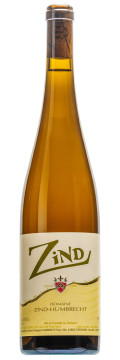
Technical presentation
| Bottling : | September 2007 |
|---|---|
| Acquired alcohol : | 14.4° |
| Residual sugar : | 6.3 g/l |
| Total acidity : | 3.5 g/l H2SO4 / (5.4g/l Tartrique) |
| pH : | 3.4 |
| Yield : | 50 hl/ha |
| Average age of vines : | 23 years |
| Grape variety : | Chardonnay / Auxerrois |
| Terroir : | Clos Windsbuhl |
| Sweetness index : | 2 |
| Format : | 75 cl |
Description of the wine Zind 2005
In 2004 we decided to bottle separately the Chardonnay (65%) and the Auxerrois (35%) grapes from the Clos Windsbuhl. In fact, the other grapes on the estate didn’t need the extra help in structure from these grapes. The Zind 2004 really shows the calcareous influence: great acidity and minerality. This persuaded us to continue in 2005. The Zind 2005 only comes from the Clos Windsbuhl with the same % of grapes. 2005 is of course riper, but still very healthy and just like the Pinot d’Alsace, it finishes fermenting only now, in January 2007! Both Auxerrois and Chardonnay are located on a rocky calcareous soil, closer to the forest surrounding the Windsbuhl, which means they are in the coolest part of the Clos, allowing the grapes to keep good acidity.
Tasting notes
01/2007 : WIP. This wine just finished to ferment in the past week. The ripeness of the grapes is very similar to the Pinot d’Alsace, but it is a completely different wine. The nose is more complex, shows more minerality and develops this textbook chardonnay/calcareous combination of buttery/toasty aromas. The palate is still difficult to judge at this stage and I might be wrong in giving an indice 2 to this wine, as the palate is firm and hides the RS very well. Bottling in September 2007.

The Clos Windsbuhl of Hunawihr
The altitude of the vineyard coupled with Hunawihr’s tardy climate means that the Clos Windsbuhl is often one of the last of our vineyards to be harvested. This explains the aromatic quality of the Clos’ wines and the consistent balance of acidity, a guarantee of good ageing. Although often harvested late, the Windsbuhl grapes are only rarely botryitized, doubtless due to the altitude of the vineyard, but nevertheless often reach high levels of maturity.
